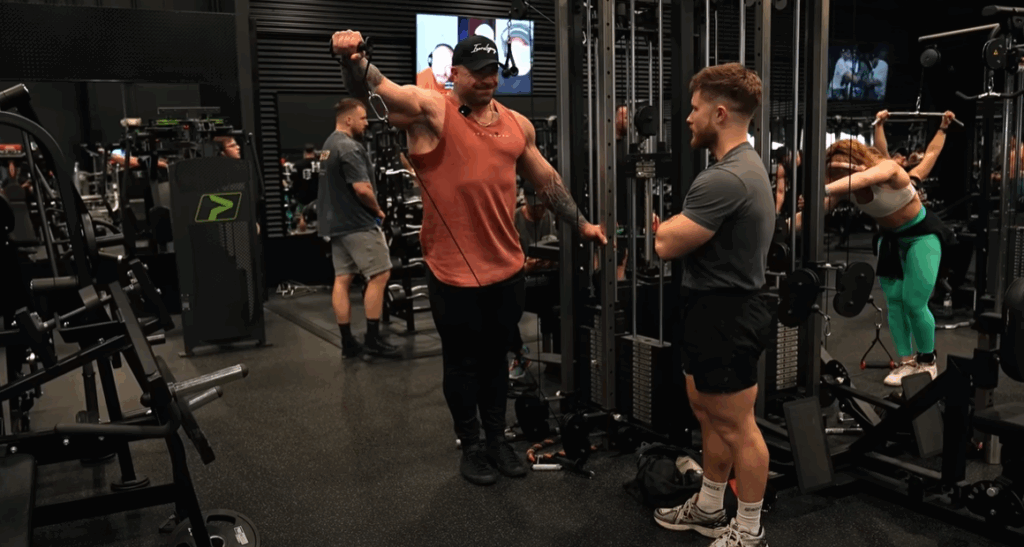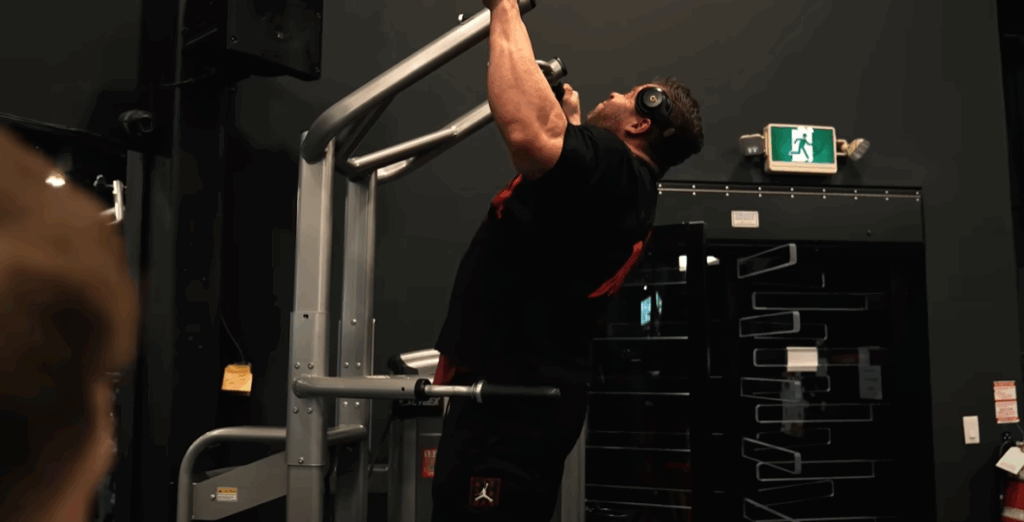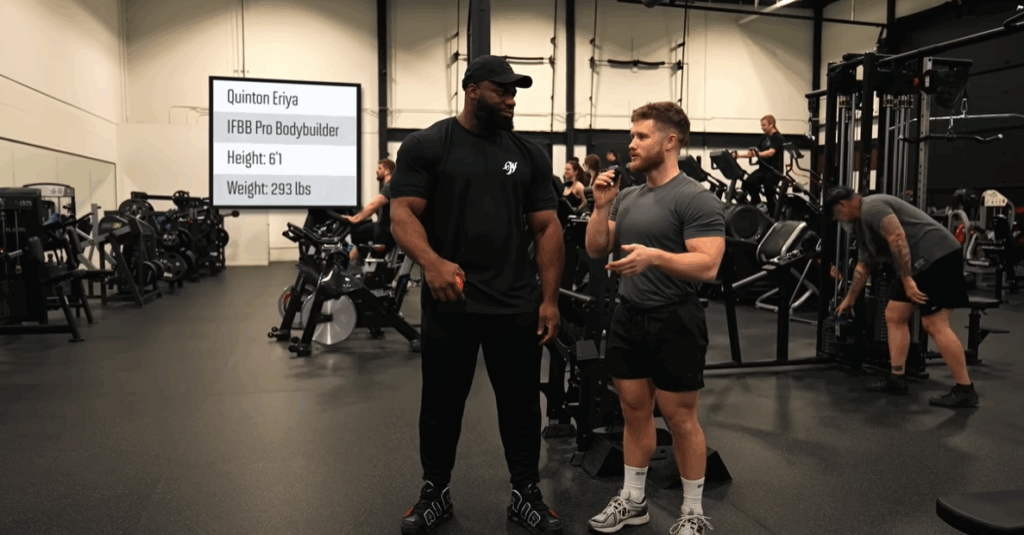n a legendary gym where massive physiques dominate every corner, where elite bodybuilders from across the world gather to push their limits, one smaller, science-driven lifter decided to test something unconventional: Would athletes with significantly more muscle be open to advice rooted in research, not just reps?
It’s a common belief that the biggest guy in the room has the best knowledge. But in the age of sports science and biomechanics, could lifting technique refined through studies, not just years under the bar, earn respect from seasoned mass monsters?
Let’s dive into what happened when scientific insight met brute strength.

Challenging the Norm: A Smaller Coach Among Giants
The experiment began with a simple question: Would massive, competitive bodybuilders take training tips from someone smaller but scientifically informed? The goal wasn’t to criticize or condescend—but to offer fresh insight and see if elite lifters are willing to listen.
Surprisingly, many said yes.
One massive lifter, whose shoulders were as wide as a door frame, was eager to chat. He was mid-way through lateral cable raises when our coach made a suggestion: raise the pulley height to align better with shoulder joint mechanics. Why? At shoulder height, tension on the deltoid is maximized when the cable and arm form a perpendicular angle. This subtle change increases muscle fiber recruitment during the stretch phase—where the most growth-stimulating damage occurs.
The bigger guy nodded. “I’m going to try that today,” he said. “Makes a lot of sense.”
Strength Meets Technique: Lessons on the Bench Press
Next came an encounter with a bench press juggernaut. The bar was loaded with nearly 500 pounds. As the plates clanged and the bar descended, raw power was on full display. But after the lift, the coach offered a tip: integrating more leg drive might further enhance pressing power.
The lifter admitted that introducing new cues sometimes distracts him, which can reduce performance. But he appreciated the thought: “It’s all about finding what clicks for you.”
This moment highlighted an important point: science-based lifting isn’t just about quoting studies—it’s about understanding how the human body moves most efficiently and matching that knowledge to the individual.

Precision Over Ego: Training the Back with Control
The coach’s next stop was a lifter performing a chest-supported row. Her technique was nearly flawless—controlled eccentrics, full range of motion, and clear activation of the upper back muscles. The only critique? None. It was an opportunity to reinforce that even elite athletes can master science-backed execution.
Too many lifters get obsessed with numbers on the stack, neglecting proper tempo and control. But muscle growth, particularly in the back, often comes from the negative—the eccentric portion of the lift. She nailed it, and the results were evident in her impressive muscularity.
The Truth About Pull-Ups at 345 Pounds
One of the gym’s largest bodybuilders, tipping the scale at over 340 pounds, was working on pull-ups with assistance. Despite his size, his control, range, and intent were exemplary. The coach praised his full range of motion—especially the deep stretch at the bottom, which activates the lats more effectively.
They discussed how assisted pull-ups can help reinforce better mechanics and muscle connection, especially for larger lifters. “A lot of guys are too proud to use assistance,” the coach said, “but it can actually make your training better.”
They also examined back width versus thickness, with some technique tweaks suggested based on whether the athlete was targeting the lats or mid traps.
Smart Volume and Training Frequency
Next came a discussion about recovery and programming. One bodybuilder, known for his symmetry and stage presence, mentioned he trains just four days a week. While this might seem low to some, the coach explained how training volume and frequency should be personalized. For advanced athletes who create extreme muscle damage in each session, longer recovery windows are often necessary.
Scientific studies typically use younger, recreational lifters as subjects—far from the elite physiques in this gym. So, while science provides a base, experience often
fills the gaps.

Advanced Techniques: Extending Sets for Growth
When one athlete mentioned his goal was building more mid-back thickness, the coach introduced a novel technique: continuing a T-bar row beyond failure by turning the movement into a shrug. Once full range rows become impossible, switching to a controlled shrug with straight arms targets the mid traps and lets the athlete squeeze out a few more reps.
These intelligent, biomechanically sound extensions to traditional sets are backed by studies on muscle hypertrophy and fatigue resistance. And the feedback? “That was solid. I’m adding this to my next session.”
Perfect Form in the Front Squat
A female competitor, prepping for an upcoming show, demonstrated her front squat. With clean execution, upright posture, and deep depth, there was little to correct. The coach emphasized how many lifters cheat their range of motion, but her full squats would build better glutes, quads, and core strength over time.
Her training frequency and volume—two lower body sessions per week, about 20 sets total—were spot on for hypertrophy and recovery balance.
Pull-Downs and Lat Isolation
One of the last athletes to receive feedback was executing lat pull-downs with remarkable control. No swinging, no trap dominance—just focused lat activation. The coach pointed out a common mistake many make: leaning back too far during pull-downs, which shifts tension away from the lats. By stopping at the point where the lats still have mechanical leverage, the lifter can maximize engagement.
Even a subtle adjustment to wrist position made a noticeable difference in contraction, and the lifter admitted it instantly felt harder—more effective.
Final Thoughts: Building Muscle with an Open Mind
Throughout the day, one thing became clear: the best athletes are always learning. Despite being visibly much larger, these bodybuilders welcomed feedback, asked questions, and showed genuine curiosity. They understood that science doesn’t replace hard work—it enhances it.
You don’t need a Ph.D. to train intelligently. But when evidence-based training meets experience in the gym, the combination can be powerful. Whether you’re a beginner or a mass monster, keeping an open mind might be the most underrated tool in your training arsenal.



